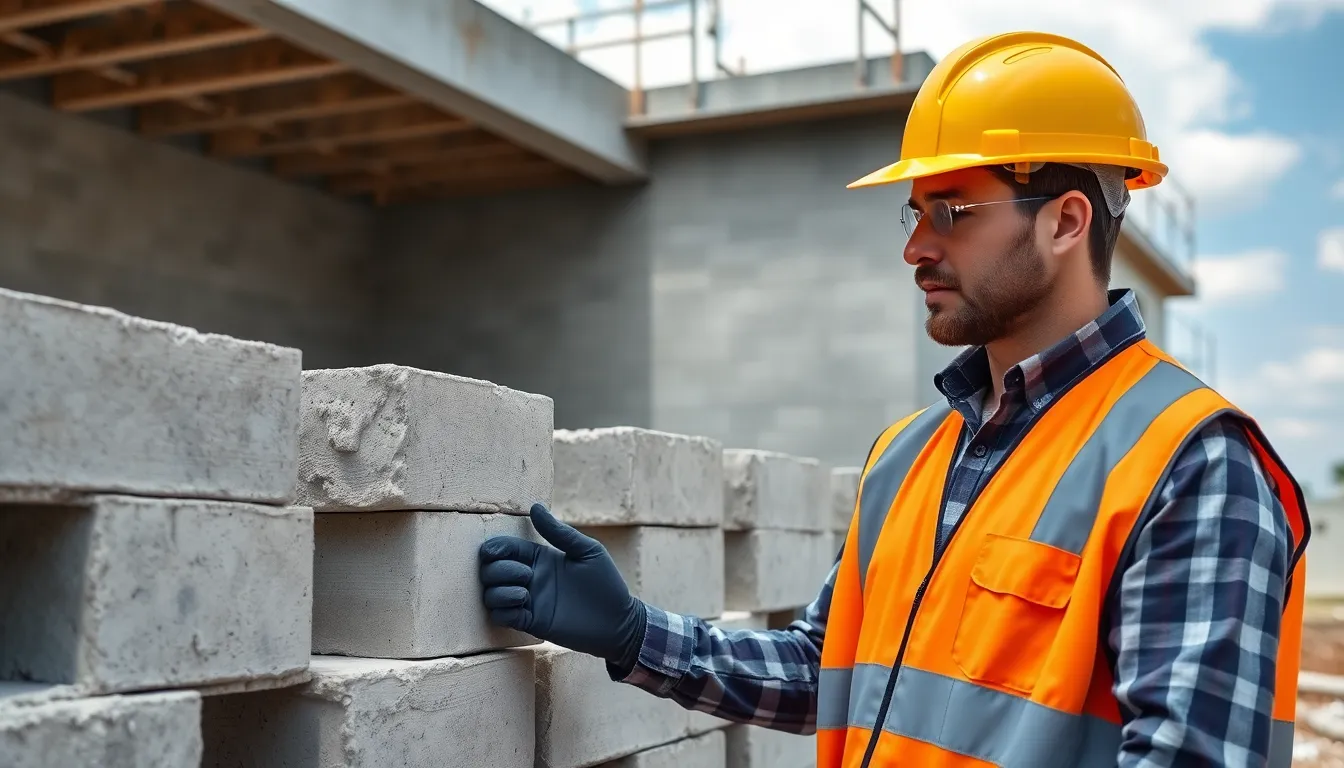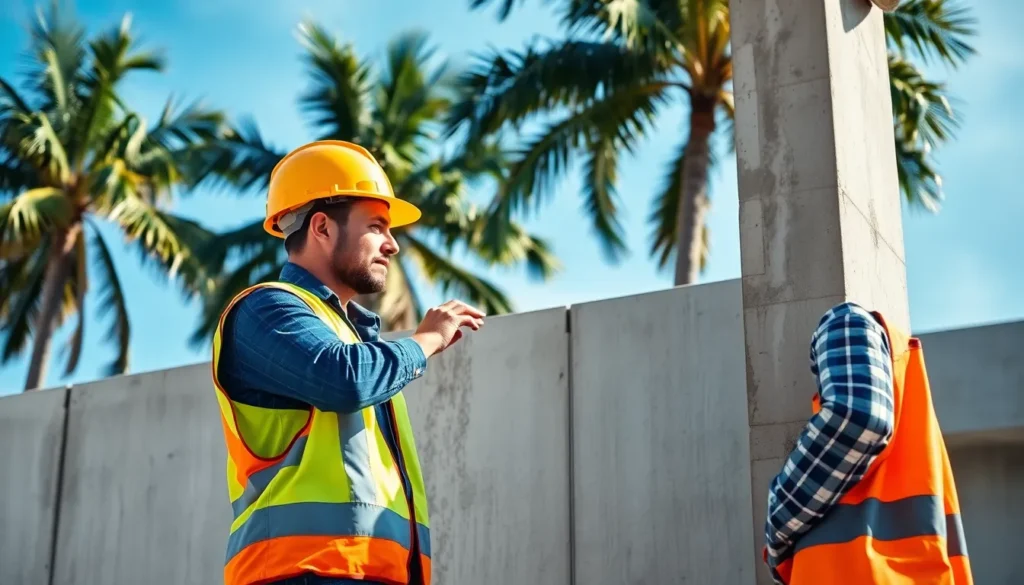When it comes to building in the Sunshine State, Florida’s building codes are as vital as sunscreen on a beach day. Exterior wall construction isn’t just about slapping on some drywall and calling it a day; it’s about creating a fortress against hurricanes, humidity, and the occasional alligator sighting.
Table of Contents
ToggleOverview of Florida Building Code
Florida’s building code outlines specific requirements for constructing exterior walls. Compliance with these codes ensures resilience against hurricanes, flooding, and high humidity. Established standards dictate materials, structural integrity, and design methods that builders must follow.
The codes address various factors, including wind loads measured in pounds per square foot. Wind load calculations play a significant role in designing walls that resist damage during storms. Construction methods emphasize using impact-resistant materials to enhance durability.
Fire-resistance ratings are crucial, especially in urban areas. Builders must consider local fire codes alongside the broader Florida building code. Compliance with these ratings minimizes fire hazards and protects occupants.
Energy efficiency is another key aspect of Florida’s building code. Requirements dictate insulation values and window performance standards that enhance energy conservation. Proper energy-efficient designs reduce utility costs and environmental impact.
Quality control measures exist throughout the construction process. Regular inspections ensure compliance with both state and local regulations. Adhering to these measures promotes safety and longevity for the structures.
Overall, Florida’s building code serves as a comprehensive guide for builders. Implementing the code’s requirements leads to safer, more sustainable buildings that can withstand the state’s challenging environment.
Importance of Exterior Wall Construction

Exterior wall construction holds significant value, especially in Florida’s unique climate. These walls play a pivotal role in ensuring safety, durability, and energy efficiency for structures in the region.
Structural Integrity
Structural integrity stands at the forefront of exterior wall construction. Florida’s building code dictates specific requirements that emphasize strength and durability. Builders must account for wind loads, especially in hurricane-prone areas. The choice of materials directly impacts structural stability; reinforced concrete and impact-resistant windows offer enhanced protection. Following wind resistance standards ensures walls endure extreme weather. Regular inspections validate adherence to these standards, promoting long-lasting structures. A well-constructed exterior wall enhances the overall safety and resilience of a building.
Energy Efficiency
Energy efficiency contributes significantly to a building’s sustainability and comfort. The Florida building code mandates specific insulation values for exterior walls. Insulation reduces heat transfer, thus minimizing energy consumption for heating and cooling. High-performance windows and proper sealing further enhance effective energy use. Cost savings on energy bills follow compliant energy-efficient designs. Builders benefit from incorporating these elements into their plans, leading to long-term advantages for homeowners. Overall, prioritizing energy efficiency in exterior wall construction aligns with environmental conservation efforts.
Key Requirements of Florida Building Code for Exterior Walls
Florida’s building code outlines essential requirements for constructing resilient exterior walls, tailored to the state’s climate challenges. Key aspects include material specifications, design considerations, and performance standards.
Materials Specifications
The code mandates the use of specific materials to enhance durability and resilience. Reinforced concrete stands as a primary choice due to its strength and ability to withstand high winds. Impact-resistant windows improve safety against debris during storms. Other materials like treated wood and insulated concrete forms help meet energy efficiency standards, ensuring homes remain comfortable year-round. Acceptable materials must exhibit properties that comply with the code’s rigorous performance criteria, focusing on moisture resistance and structural integrity.
Design Considerations
Design strategies must address Florida’s unique environmental challenges. Builders must incorporate wind load calculations into their designs to ensure structures can resist hurricane forces. It’s crucial to follow the code’s specifications for wall anchorage and support systems to enhance stability during adverse weather conditions. Orientation and shading in building design help improve energy efficiency, while proper ventilation reduces moisture buildup. Emphasizing aesthetic considerations alongside structural requirements creates visually appealing, functional homes.
Common Types of Exterior Wall Construction
Exterior wall construction in Florida varies based on materials and design methods. Each method must comply with building codes that ensure durability and resilience against harsh conditions.
Wood Frame
Wood frame construction often serves residential buildings due to its cost-effectiveness and ease of assembly. Builders use treated lumber that stands up against rot and insects, adhering to Florida’s stringent building codes. This method allows flexibility in design, accommodating various architectural styles. Insulation plays a vital role in energy efficiency, with codes dictating minimum R-values for walls. Regular inspections ensure that framed walls meet structural integrity standards, crucial for hurricane-prone areas.
Concrete Block
Concrete block construction offers enhanced durability and strength, making it a popular choice in Florida. Blocks provide resistance to hurricanes, moisture, and pests, meeting state building regulations effectively. This method allows for various finishes, enhancing aesthetic appeal. Energy efficiency benefits from the thermal mass of concrete, aiding in temperature regulation. Wall performance testing verifies compliance with Florida’s energy codes and structural requirements, making concrete blocks a reliable choice for resilient structures.
Steel Frame
Steel frame construction is increasingly favored for its strength and ability to withstand extreme weather conditions. Builders utilize steel studs, which provide superior structural integrity while minimizing fire risk. This construction type aligns with Florida’s building codes, particularly in coastal regions. Insulation must meet energy efficiency standards, contributing to lower utility costs for occupants. Additionally, corrosion-resistant treatments enhance the longevity of steel frames, ensuring they comply with Florida’s durability mandates. Regular inspections help maintain code adherence, ensuring safety and reliability.
Best Practices for Compliance
Ensuring compliance with Florida’s building codes requires attention to detail throughout the exterior wall construction process. Prioritize using materials that meet or exceed the code requirements for durability and energy efficiency. Examples include reinforced concrete and impact-resistant windows, which enhance strength against hurricanes.
Adhering to wind load calculations remains critical for structural integrity in hurricane-prone areas. Calculate expected wind loads based on local factors and incorporate these values into design plans. Installing proper anchorage and support systems guarantees stability during adverse weather.
Regular inspections play a significant role in maintaining compliance. Schedule inspections at various stages of the construction process to identify potential issues early. Document findings meticulously to ensure all construction adheres to the mandated standards.
Energy efficiency standards must also be integrated into exterior wall designs. Insulation values specified in the code directly affect energy consumption levels. High-performance windows and proper sealing techniques augment energy savings for homeowners.
Fire-resistance ratings should not be overlooked, especially in urban areas. Compliance with local fire codes contributes to reduced hazards and improved safety. Builders should consider integrating fire-resistant materials whenever possible.
Design strategies must take orientation, shading, and ventilation into account. These factors significantly influence energy efficiency and moisture management in structures. Thoughtful design can reduce energy consumption while ensuring comfort for occupants.
Finally, recognizing the unique challenges Florida’s climate presents will guide effective wall construction. Tailor strategies to address issues such as humidity and flooding. Emphasizing proper techniques and adhering to building codes leads to safe and sustainable buildings.
Florida’s building code for exterior wall construction is essential for creating safe and resilient structures. By adhering to these regulations, builders can ensure that homes and commercial buildings withstand the state’s unique climate challenges. The emphasis on structural integrity, material specifications, and energy efficiency not only enhances safety but also promotes sustainability.
Regular inspections and compliance with established standards are crucial for maintaining the quality of construction. As Florida continues to face natural threats, understanding and implementing these building codes will lead to long-lasting and energy-efficient buildings. This commitment to quality and resilience ultimately benefits homeowners and the broader community.



